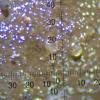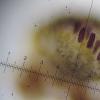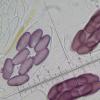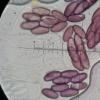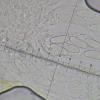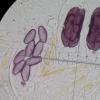
20-01-2014 21:32
Hello,I found this white saccobolus on sheep dung.

19-01-2014 13:56
hannie wijersOn the dung of deer I found two hairy frb. The hai

19-01-2014 18:11
hannie wijersHello everyone, On the dung of a deer I found thi

17-01-2014 13:12
Garcia SusanaHi allApothecia inmersed, 0.4mm diameter. Hymenium

18-01-2014 22:12
 Joop van der Lee
Joop van der Lee
Found on deer dung. Fruitbody covered with septat
Saccobolus saccoboloides?
Ralph Vandiest,
20-01-2014 21:32
I found this white saccobolus on sheep dung. Size 0,3mm, spore clusters 44/50x17/25µm, spores 18/19x8/9µm. Clustered 8 spored (4rows of 2), loose clustered, free at maturity. Can somebody confirm this species?
Regards,
Ralph
Peter Püwert,
20-01-2014 21:54
Re : Saccobolus saccoboloides?
Hello Ralph,
in my opinion is this Sacc. citrinus. The form (truncate ends) an the warted spores is a reference and the enlarged paraphyse (3. photo left up) too.
Greetings Peter.
in my opinion is this Sacc. citrinus. The form (truncate ends) an the warted spores is a reference and the enlarged paraphyse (3. photo left up) too.
Greetings Peter.
Ralph Vandiest,
20-01-2014 22:12
Norbert Heine,
20-01-2014 22:27

Re : Saccobolus saccoboloides?
Hello Ralph,
I think Peter is right with Saccobolus citrinus!
Your first picture shows a typical overripe Saccobolus.
Then you must not be surprised, when the clusters are loose!
Regards
Norbert
I think Peter is right with Saccobolus citrinus!
Your first picture shows a typical overripe Saccobolus.
Then you must not be surprised, when the clusters are loose!
Regards
Norbert
Peter Püwert,
20-01-2014 22:36
Re : Saccobolus saccoboloides?
Hello Ralph,
probable is the pressure by the preparation to powerful ? V. Brummelen wright, that the clusters not shortened with ripening,
Greetings Peter.
Edit: In addition respectively at first the remark from Norbert of course.
probable is the pressure by the preparation to powerful ? V. Brummelen wright, that the clusters not shortened with ripening,
Greetings Peter.
Edit: In addition respectively at first the remark from Norbert of course.
Ralph Vandiest,
20-01-2014 22:38
Re : Saccobolus saccoboloides?
Hello Peter & Norbert,
Thx a lot for your answers. It must be indeed S citrinus.
regards,
Ralph
Thx a lot for your answers. It must be indeed S citrinus.
regards,
Ralph



